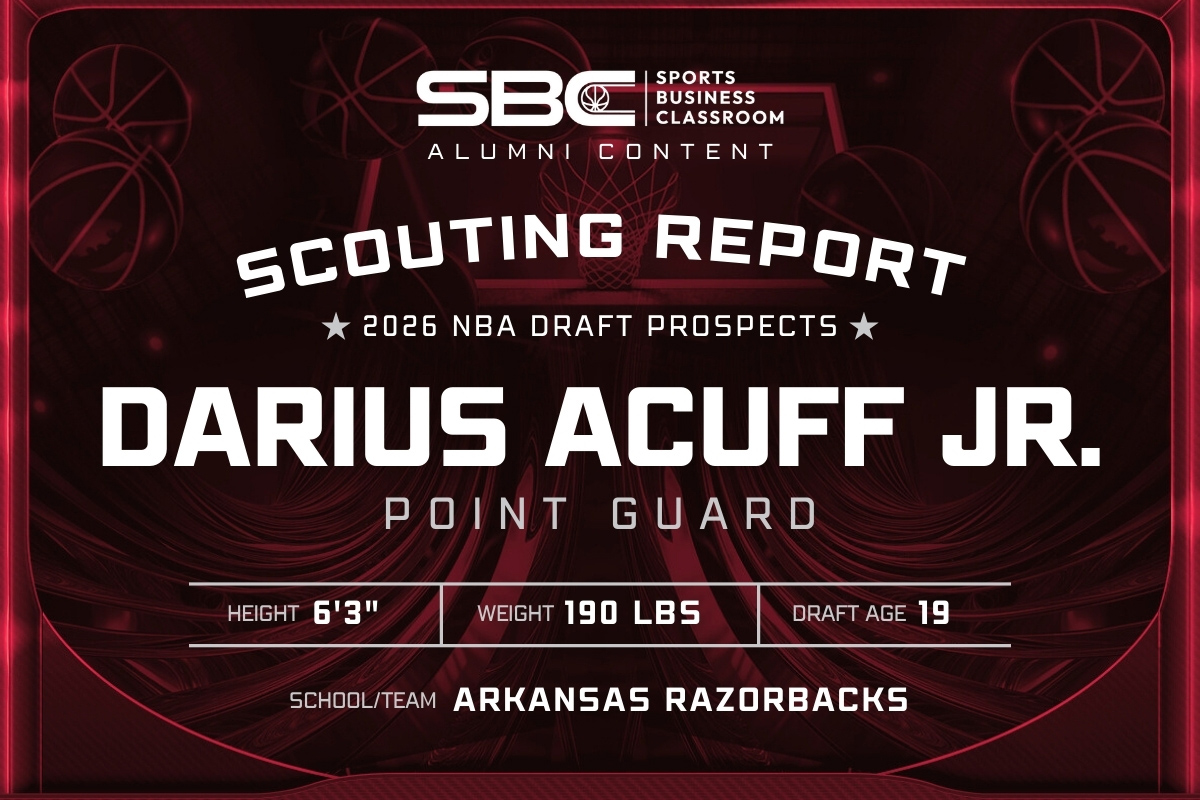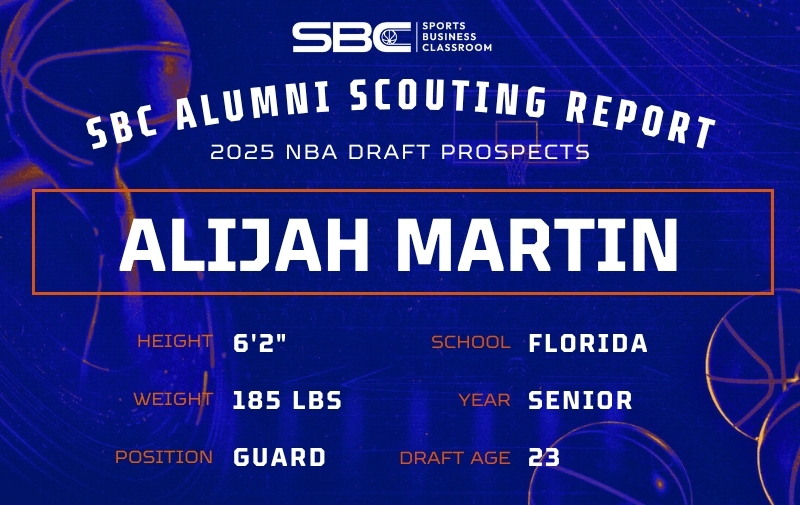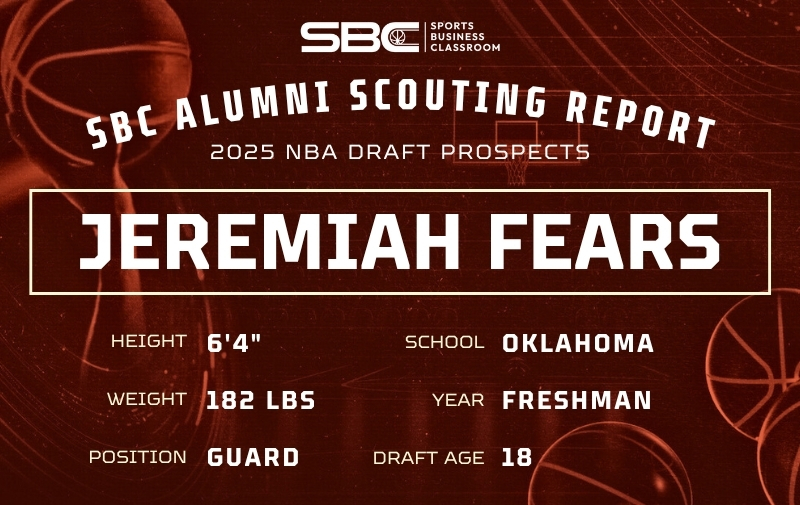
[The following scouting report is part of a series on potential 2025 draft prospects from Sports Business Classroom alumni.]
Chaz Lanier
Frame: 6’5″, 207 lbs
Position: Guard
Team: Tennessee Volunteers
2025 Draft Age: 23
Stats via www.sports-reference.com
Offense
Lanier has established himself as one of the country’s best players through perimeter shooting. Lanier’s shot is tough to contest with a compact frame, pristine mechanics, and picture-perfect release. He is averaging 43.7 from three on 135 attempts (81.4 percent assisted)
Lanier squares up to the basket on all his attempts and primarily thrives coming off screens, where he can rise into his shot. Lanier’s’ mechanics aid him in having a quick trigger, which makes him a dangerous spot-up shooter, getting it off before most defenders reach his vicinity. His efficiency is further validated by his free throw shooting as a career 84.3 percent shooter on 198 attempts. He can also shoot off the dribble, mainly when coming off ball screens against drop coverage, where he can take one to two dribbles and shoot without much resistance. Lanier can find himself in trouble against more athletic defenders, who can stick to his hip and fight through screens, as he does not have the speed or ball handling to get defenders off him on or off the ball—leading him to struggle when coach Rick Barnes can’t’ get him open looks through stagger screens or pin-downs.
Lanier’s’ shooting has also translated to the mid-range, shooting 38.5 percent on 78 attempts (23.3 assisted). Like his three-point shots, Lanier is best when taking as few dribbles as possible to get to his spots—typically attacking off the catch, where he can rise after one or two dribbles. Tennessee also runs him off of pin-downs to get him open looks around the elbow where he can shoot without putting the ball on the floor. Lanier has flashed being able to use his physicality against smaller defenders, backing them down with his shoulder and fading away for a clean look. But he can struggle against bigger defenders due to his lack of an advanced handle to get separation, which could plague Tennessee down the stretch of the season into March.
The athletic deficiencies also hinder Lanier around the rim, shooting 50.0 percent on 34 attempts (47.1 percent assisted). Lanier struggles to put defenders behind him with below-average handles and burst. His defender is typically at his hip when Lanier tries to drive downhill. He is not an above-the-rim finisher, so he has difficulty adjusting to contact, especially against rim protectors. However, Lanier can rise for some impressive dunk attempts but is usually unable to convert on them, resulting in foul calls on the defense. He typically finishes with his right hand but can use his left when he has a clear lane.
In his current role, Lanier doesn’t facilitate the offense much. He doesn’t make advanced passes but isn’t asked to do so in this offense. Lanier averages only 1.3 assists, with an assist percentage of 9.7 percent, and 1.1 turnovers, with a turnover percentage of 8.4 percent. He can make the obvious pass and won’t’ force bad shots when a teammate is open. However, Lanier does not excel at baiting defenders and table setting for teammates, nor will he be asked to.
Defense
While not a stalwart defensively, Lanier is more than capable of being a sound defender. He moves his feet laterally and uses his strength and size well to keep perimeter players in front of him. Lanier is a bit upright in his defensive stance, which can lead to guards getting under him and consequently getting past him. He knows how to navigate pick-and-rolls defensively by getting through ball screens and knowing when to go under or over said screen. Lanier can struggle to contest the shots of bigger offensive players. He has shown some resistance against big men on switches in the post, but he can only do so much with his size. Occasionally, Lanier will pluck the handle of a perimeter player, typically a smaller guard, but doesn’t go for turnovers, only averaging 1.3 steals with a steal percentage of 2.5 percent.
Much of the same can be said for Lanier’s’ off-ball defense. He does a good job staying alert and keeping his man nearby so that he can play the ball or his man should he receive a pass. He keeps his head on a swivel and will switch to a different offensive player should a teammate get caught in an off-ball screen. Lanier will rotate from the weak side and help contest a shot around the rim or stunt at a driving offensive player when positioned on the strong side. Lanier does not generate many turnovers as a help defender. However, picking off the occasional pass on the strong side offers little weak side rim protection, averaging 0.2 blocks with a block percentage of 0.3 percent.
Looking Ahead
In his fifth season, Lanier has earned national headlines. The North Florida transfer has largely filled the void left by Dalton Knecht as Tennessee’s’ best shooter and perimeter scorer. With his quick trigger and sound mechanics, Lanier is one of the best shooters in the class and can plug into an NBA rotation from day one. However, his lack of offensive upside while being a solid but not special defender hinders his upside and overall stock.
Lanier projects to be a back-end rotation piece with some upside as a quality offensive player and projects as a late second-round pick.






